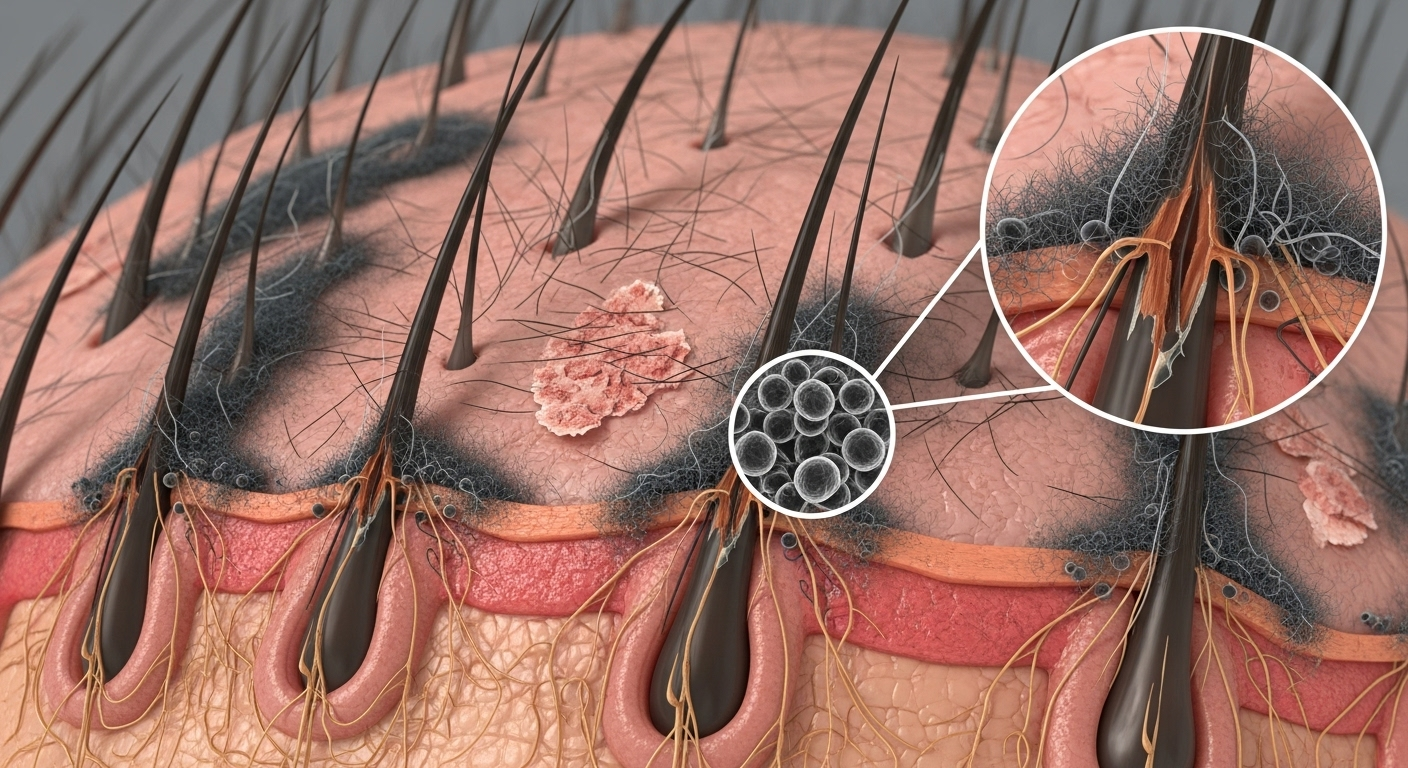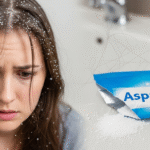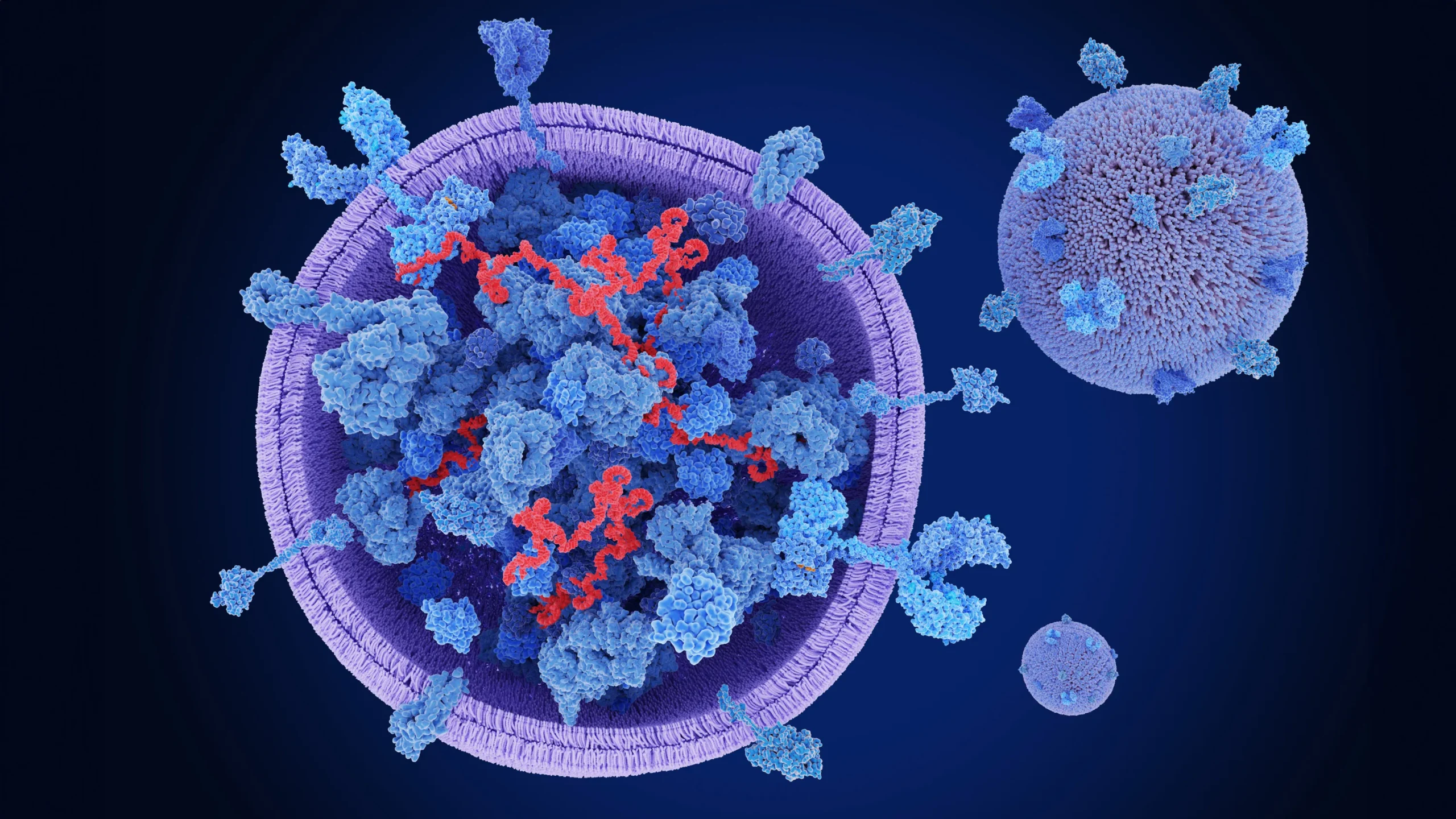Black mold exposure is a serious health concern that affects many people, often leading to respiratory issues, skin irritation, and even hair loss. Black mold hair loss is a condition that occurs when mold exposure triggers an inflammatory response in the scalp, weakening hair follicles and promoting shedding. In this article, we will explain the …
Black mold exposure is a serious health concern that affects many people, often leading to respiratory issues, skin irritation, and even hair loss. Black mold hair loss is a condition that occurs when mold exposure triggers an inflammatory response in the scalp, weakening hair follicles and promoting shedding.
In this article, we will explain the connection between black mold and hair loss, how mold toxins affect your hair, and how to prevent and treat this type of hair loss.
If you’ve been experiencing hair thinning or shedding due to mold exposure, keep reading for solutions that can help restore your hair health.
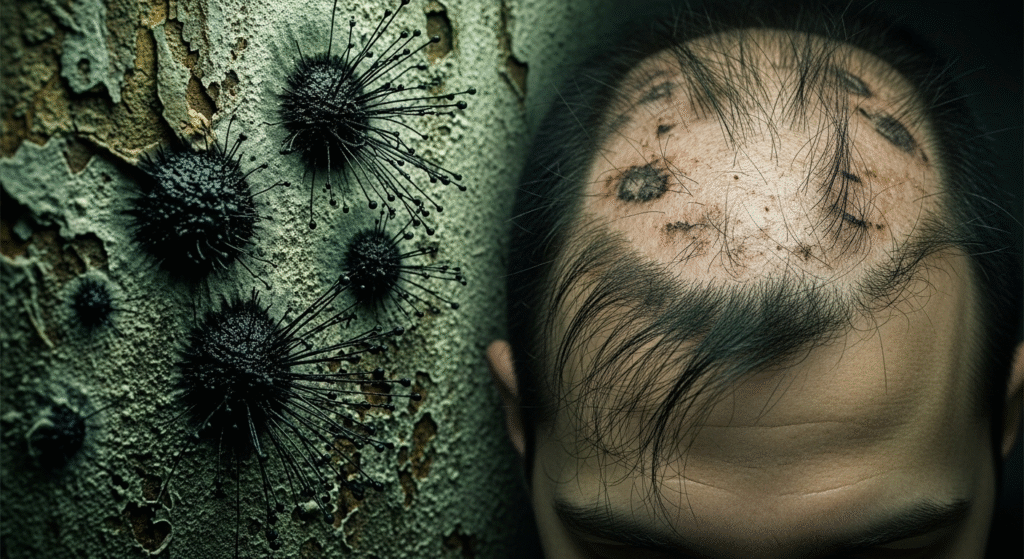
Understanding Black Mold and Hair Loss and Its Impact on Health
Before diving into how black mold affects hair, it’s important to understand what black mold is and why it’s hazardous to health.
What is Black Mold?
Black mold, scientifically known as Stachybotrys chartarum, is a type of mold that thrives in damp, poorly ventilated environments. It often appears black or greenish-black and has a musty odor.
Black mold grows on materials like wood, drywall, and carpet when exposed to excess moisture, especially in areas affected by water leaks or high humidity.
How Black Mold Affects the Body
Black mold releases mycotoxins, toxic substances that can cause serious health problems when inhaled, touched, or ingested. Common symptoms of black mold exposure include:
- Respiratory issues, like coughing, wheezing, and shortness of breath.
- Skin irritation or rashes.
- Chronic headaches and fatigue.
- Hair loss: Mold exposure can lead to scalp irritation, inflammation, and hair thinning.
Mycotoxins can directly affect the scalp and hair follicles, leading to hair loss or thinning, especially in people with sensitivities or allergies.
Black Mold and Hair Loss: Is There a Link?
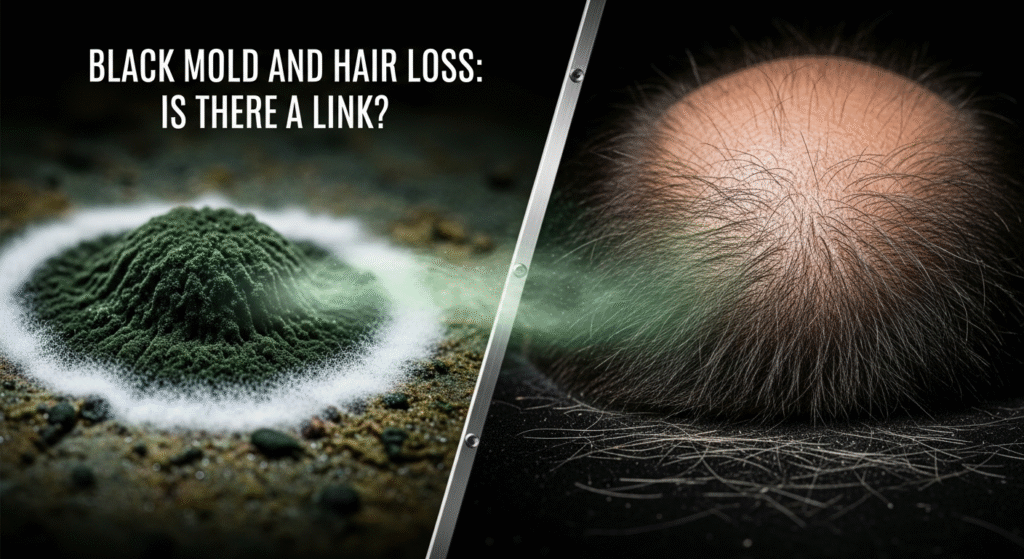
So, how exactly does black mold contribute to hair loss? Let’s explore the science behind it.
How Mold Toxins Affect Hair Growth
When exposed to black mold, the body reacts by releasing an immune response to fight the mycotoxins. This immune response leads to inflammation in various areas, including the scalp. Chronic inflammation can damage hair follicles and disrupt the hair growth cycle, leading to hair shedding or thinning. The mycotoxins can also affect the hormone levels responsible for hair growth, leading to further hair loss.
Impact on Scalp Health
The scalp is a sensitive area that is highly affected by fungal infections and environmental pollutants like mold. Mold spores that settle on the scalp can cause localized infections, making the scalp prone to dandruff, itchiness, and irritation. These issues can obstruct hair follicles, preventing healthy hair growth and causing existing hair to fall out.
Increased Sensitivity in People with Mold Allergies
People with mold allergies are at a heightened risk of hair loss because their bodies are more sensitive to mold’s harmful effects. An allergic reaction can lead to excessive inflammation and worsen scalp conditions, which can exacerbate hair thinning.
Symptoms of Black Mold and Hair Loss
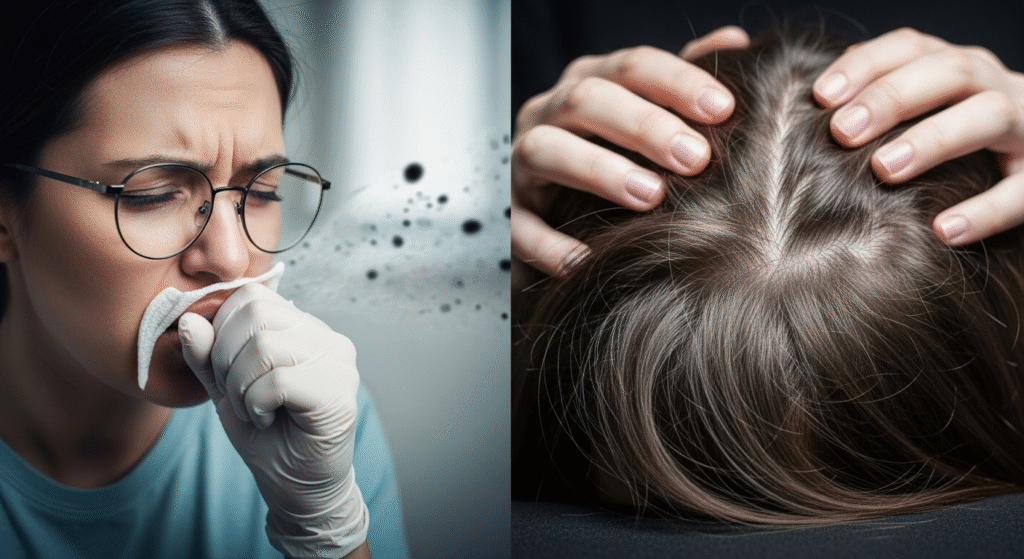
Black mold exposure doesn’t just affect your hair; it impacts your overall health. Identifying the symptoms of mold exposure can help you take the necessary steps to protect your health and hair.
Physical Symptoms of Mold Exposure
In addition to hair loss, black mold exposure can lead to a variety of symptoms, including:
- Respiratory Issues: Coughing, wheezing, and nasal congestion.
- Skin Irritation: Redness, rashes, and itching.
- Headaches and Fatigue: Chronic tiredness and difficulty concentrating.
How Mold Exposure Can Lead to Hair Loss
Hair loss caused by mold exposure is primarily due to the inflammatory effects of mold toxins. The toxins cause damage to hair follicles, leading to thinning or shedding. Prolonged exposure can lead to a condition known as telogen effluvium, where hair enters the resting phase and eventually falls out. This form of hair loss is often temporary, but without intervention, it can become permanent.
Identifying Mold-Induced Hair Loss
The key signs of mold-induced hair loss include:
- Patchy Hair Loss: Areas of thinning or balding on the scalp.
- Excessive Shedding: Hair falling out in large amounts, especially after showering or brushing.
- Scalp Irritation: Redness, itching, or discomfort on the scalp.
If you notice these symptoms and suspect mold exposure, it’s important to address both the mold issue and the hair loss at the same time.
Preventing Hair Loss Due to Black Mold Exposure
The first step in preventing mold-induced hair loss is to remove the source of the mold. Here are steps you can take to protect your health and hair.
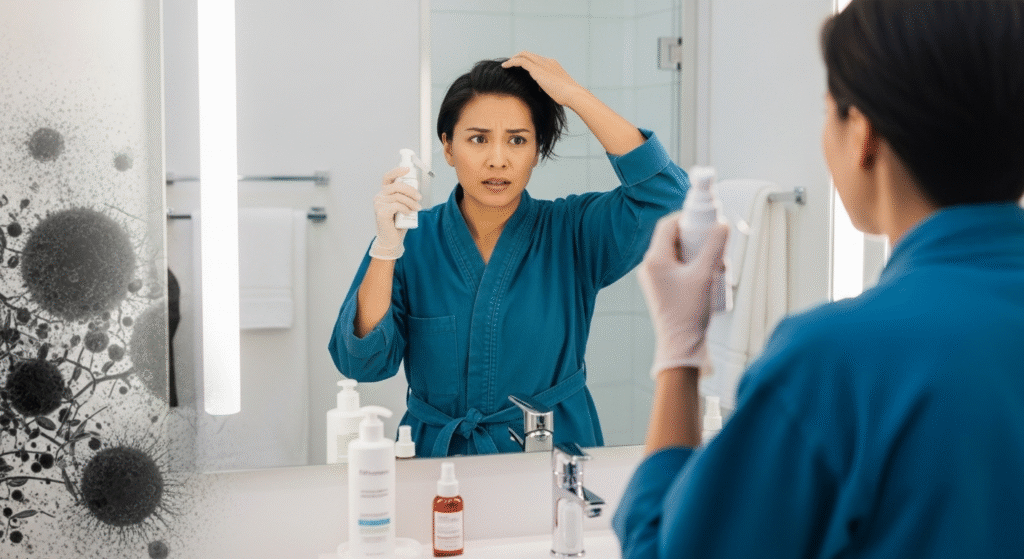
Identifying and Removing Black Mold from Your Home
The presence of black mold in your home can lead to ongoing exposure, making it critical to identify and remove it. Mold thrives in areas with high moisture, so check areas such as:
- Bathrooms: Around sinks, bathtubs, and toilets.
- Basements: Especially in corners and areas with water damage.
- Attics: Areas with poor ventilation and potential leaks.
You can remove small patches of mold using DIY solutions, like vinegar or hydrogen peroxide. However, for larger infestations, it’s essential to call a professional mold remediation specialist who can safely remove the mold and prevent future growth.
Improving Air Quality and Ventilation
Ventilating your home properly is key to preventing mold growth. Use dehumidifiers to keep humidity levels in check and ensure proper airflow in damp areas. Regularly open windows and use exhaust fans in bathrooms and kitchens to keep moisture levels low.
Protective Measures for Sensitive Individuals
If you are sensitive to mold, use protective gear when cleaning or handling mold-infested areas. This includes wearing masks, gloves, and goggles to minimize exposure. If you live in an area prone to mold, consider installing air purifiers to reduce airborne mold spores.
Treatment Options for Black Mold and Hair Loss

If you’re already experiencing hair loss due to mold exposure, it’s essential to treat both the mold problem and the hair loss simultaneously.
Medical Treatments for Hair Loss Caused by Mold
Consult a dermatologist if you are experiencing significant hair loss due to mold. They may recommend topical treatments like minoxidil to stimulate hair growth. For more severe cases, a dermatologist may prescribe corticosteroids to reduce inflammation on the scalp.
Home Remedies and Scalp Care for Black Mold and Hair Loss
In addition to medical treatments, you can use home remedies to help restore scalp health and encourage hair regrowth. Some effective treatments include:
- Coconut Oil: Known for its antimicrobial properties, coconut oil can help soothe an irritated scalp and promote hair health.
- Aloe Vera: Aloe vera gel can help reduce inflammation and provide moisture to the scalp, aiding in healing.
When to Seek Professional Help for Black Mold and Hair Loss
If hair loss persists after mold removal or if you are experiencing severe thinning, it’s crucial to seek professional help. A dermatologist or trichologist can assess the damage and recommend specific treatments for your hair.
FAQs
Can Mold Really Cause Hair Loss?
Yes, mold exposure can lead to hair loss by causing inflammation of the scalp, which disrupts the normal hair growth cycle. The mycotoxins released by mold can damage hair follicles and contribute to hair thinning or shedding.
How Long Does It Take to Recover from Hair Loss Caused by Black Mold?
The timeline for hair regrowth depends on the severity of mold exposure and the steps taken to treat both mold and hair loss. In general, visible results may take 3–6 months with proper treatment and scalp care.
Is Mold-Induced Hair Loss Permanent?
No, mold-induced hair loss is typically not permanent. With mold removal and proper hair treatments, hair regrowth can often occur. However, severe or prolonged exposure may cause lasting damage to hair follicles.
What Other Health Issues Can Black Mold Cause?
In addition to hair loss, black mold can cause respiratory issues, headaches, chronic fatigue, skin rashes, and even neurological problems in sensitive individuals.
Conclusion
Black mold exposure can seriously impact both your health and hair. By addressing mold problems in your living space and following proper hair care treatments, you can protect your scalp and encourage hair regrowth. If you’re struggling with hair loss caused by black mold, seek professional advice to ensure you take the best steps for recovery.
Book a consultation with our specialists Dr. Uzma Irfan, an ISHRS-certified surgeon in Islamabad today to discuss mold removal and hair restoration solutions.

